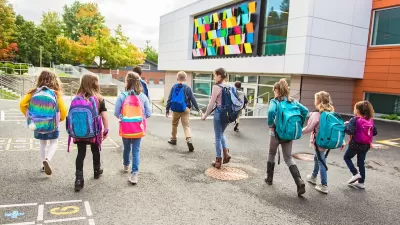Students in Ohio State University's City and Regional Planning department worked closely with the Franklinton neighborhood in Columbus to create a new vision for the community.
"Throw a stick from any corner along Columbus' east-west artery of Broad Street and you'll likely hit an area that somebody hopes will become the city's next great urban neighborhood. But few have drawn as much consideration as the historic area of Franklinton, made viable this century by its location in the morning shadow of Downtown and the completion of the Scioto River floodwall.
Last week, a group of master's candidates in OSU's Knowlton School of Architecture's City and Regional Planning program unveiled an extensive, deeply researched plan for the neighborhood, called for by the Franklinton Development Association.
Mark Lundine is one of the students responsible for the plan. Having worked on the city's 2012 initiative as an intern, he was well acquainted with the growing desire for affordable urban housing, as well as space and ownership for artists that have been priced out of the Short North.
Lundine spoke to Alive about the five key principles that would guide Franklinton development."
FULL STORY: On principles

Planetizen Federal Action Tracker
A weekly monitor of how Trump’s orders and actions are impacting planners and planning in America.

Chicago’s Ghost Rails
Just beneath the surface of the modern city lie the remnants of its expansive early 20th-century streetcar system.

San Antonio and Austin are Fusing Into one Massive Megaregion
The region spanning the two central Texas cities is growing fast, posing challenges for local infrastructure and water supplies.

Since Zion's Shuttles Went Electric “The Smog is Gone”
Visitors to Zion National Park can enjoy the canyon via the nation’s first fully electric park shuttle system.

Trump Distributing DOT Safety Funds at 1/10 Rate of Biden
Funds for Safe Streets and other transportation safety and equity programs are being held up by administrative reviews and conflicts with the Trump administration’s priorities.

German Cities Subsidize Taxis for Women Amid Wave of Violence
Free or low-cost taxi rides can help women navigate cities more safely, but critics say the programs don't address the root causes of violence against women.
Urban Design for Planners 1: Software Tools
This six-course series explores essential urban design concepts using open source software and equips planners with the tools they need to participate fully in the urban design process.
Planning for Universal Design
Learn the tools for implementing Universal Design in planning regulations.
planning NEXT
Appalachian Highlands Housing Partners
Mpact (founded as Rail~Volution)
City of Camden Redevelopment Agency
City of Astoria
City of Portland
City of Laramie





























